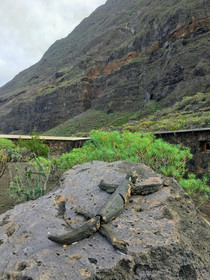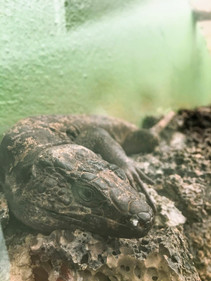We're Off to See the Lizards: Finding the Real-life Dragons of El Hierro
- Sadie Williams

- Nov 25, 2018
- 5 min read
Recently, I went to the Ecomuseo de Guinea in the province of Frontera to see the famed Giant Lizards of El Hierro, volcanic tubes, and old houses from the 18th, 19th, and 20th centuries.
Frontera is one of three provinces in El Hierro, closer to the middle of the island and just a little smaller than the big city of Valverde (Frontera has just under 4,000 people while Valverde has nearly 5,000). To get there, you descend the mountain from Villa de Valverde, then go through a long, dark tunnel directly through the mountain. It is an incredible view, all towering cliffs and glittering ocean views. On bright days, you can see La Gomera, La Palma, and Tenerife!
Just outside the city of Frontera is the Ecomuseo, which includes volcanic tubes, giant lizards, and old houses where herreños lived centuries ago. The museum requires a guided tour, but fortunately, I managed to get there just in time for one to leave. There were several people from Gran Canaria, a few families from La Palma (another small island near El Hierro), and even a couple of Germans!
First, we descended into the volcanic tubes, which were very interesting. We saw oxidized copper that turned the rock moss green, some cool rock formations, and a giant hole in the top of one tube. According to legend, the giant hole was caused because a monk decided to work on a garden on the Sabbath (even though he knew better), so God struck him down with lightning, destroying the cave in the process. One cavern was so large and spherical that it had amazing acoustics, and sometimes they have small concerts inside the cave!
After emerging from the volcanic tubes, we walked along a pretty rock path lined with interesting plants and with stunning views of Frontera and the sea. There was also some interesting art made from wood and rocks, portraying giant lizards, the true star of this museum.
I was very excited to see the lizards! They are indeed giant, about two feet long, and as far as I can tell their favorite pasttime is sleeping in the sunshine. Not a bad life! Their home is officially called the Lizard Recovery Center, and the goal of the center is to help the population recover.
The lizards were once found all over El Hierro, but now there are only about 300 left in the wild. They live up in the high cliffs of Frontera and are critically endangered, mainly due to hunting by the bimbaches (the native people of El Hierro) and habitat loss. They are mentioned in many historical reports, including the chronicles of the King of Mauritania Tingitana Juba II in 200 BC.
In the Franco-Normand Chronicles of the invasion of El Hierro in 1404, there is mention of a "huge lizard the size of a cat, that are neither harmful nor poisonous, but disgusting and repulsive to look at."
I think this is a bit of an overreaction; the lizards seemed pretty cute to me. :)
Another thing I learned is that the lizards apparently love tomatoes, so they will come check out any place that throws away tomatoes in large quantities. Which includes basically every restaurant, hotel, and most households in Spain. Also, in the 1940s, some scientists got a little too excited and almost wiped out the population with scientific sampling. They were thought to be extinct until 1974, when an old British man by the name of Werner Bings came to El Hierro claiming to be a researcher with a lead on finding the lizards alive and well. Local shepherds helped him find some surviving animals, only to find out at the last minute that he was a private lizard collector and planned to take the lizards back to England to complete his collection! The head of the forestry department, Zózimo Hernández Martin, heroically stopped him from taking the giant lizards and restricted access to the lizards for several years afterwards. So the rediscovery of the lizards was quite the adventure!
In 1985, Operation "Save the El Hierro Giant Lizard" was put into action, and the center has been working to save the lizards ever since. The center recently had a great success, and they currently have a hundred new baby lizards! :D They feed them insects, native plants, and only a few tomatoes as a treat every now and then.
Check out some of the lizards I saw below! They are well-camouflaged, so some of the pictures involve a little bit of I Spy. :)
The lizards live in large model habitats, complete with heat lamps and fresh air. All the guys you see above are males, because seeing people stresses out the females and then they don't lay as many eggs.
Another problem with reproduction rates is that mommy lizards lay their eggs pretty deep underground to keep them safe, and they dig a little tunnel. However, then they leave the eggs to make their own way. When the baby lizards hatch, they don't know about the tunnel so they dig straight up to get to fresh air. Which, as you can imagine, is pretty hard work!


After we left the lizard sanctuary, we went to the ethnographic part of the museum where we saw some very neat old houses where local people lived in the 18th, 19th, and 20th centuries. I couldn't take pictures inside the homes, but some highlights were a mouse trap that looked like a torture device of some sort, a very old meat grinder, and some beautiful bedcovers made of wool. The houses were all made of stone, and I found it super interesting that the stones weren't cemented together with anything; they were just stacked tightly together. The roofs were made of grass, and held down by this one log attached to a rope (see below). You tie the log to the rope, sling it over the top of the house, and stick the log directly between the stones of the house. And that's how you keep a roof over your head!
More lovely views of the rugged-looking mountains!
The museum is easily accessed by bus #3 from Frontera or Valverde and is open from 10:00am to 6:00pm every day, but make sure to get there by 4:00pm because that is when the last tours leave.
It was a lovely day seeing the lizards (on my list since September), exploring more of the history of El Hierro, and seeing another province!
"The Hierro Giant Lizard is a precious reminder of the distant past and an emblematic symbol of the island and its people. It is living proof of the positive efforts in the conservation and protection of endangered species all over the world."










































































Comments